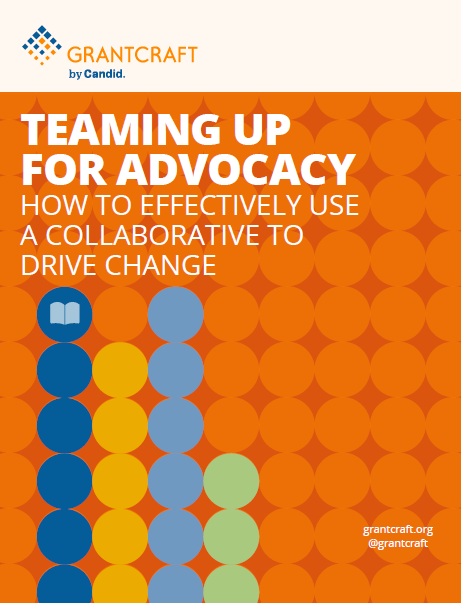Does Size Matter?
Ask grantmakers what the biggest hurdles are in any kind of collaborative venture, and 99 percent will mention the tension between “the big foundations and the small ones” or “the national funders and the local funders.” Because policy work occurs at the local, state, regional, and national levels, it’s important that advocacy collaboratives try and involve grantmakers working at all these points.
Unfortunately, that isn’t always the case. As one funder recalls, “We had national and local funders, and there was an awful lot of tension between the two. A set of the national funders, especially, thought they knew everything and how the work should roll out. They weren’t respectful or kind to the local funders, who they thought should be grateful just for participating in the meetings but letting national funders call the shots. National funders were arrogant. Local funders were angry, saying, ‘we live here and we know what’s going on.’”
Left unaddressed, this split can torpedo a collaborative’s carefully-designed strategy. As one local grantmaker shared, “When the big funders think it’s a good moment to do something at the federal level, that changes what happens on the ground because they control resources. We were doing a lot of mixed grantmaking at the local and federal levels, but when a federal policy opportunity was imminent, we all had to get on board behind that because the big funders were going there.”
Tension around these issues can lead to member drop off. “There’s always been a little tension about the big funders and too much deference to them. It’s a delicate balance between having a democratic process and knowing that the collaborative still has to fundraise from donors, especially the big foundations. And they have to keep those major donors happy. That makes it hard for a minority donor or one who’s not mainstream. You have a say, but you’re still a minority. I knew that so I kept my investment at the minimum amount. When they raised it, I left.”
Stories From the Real World
When I was a program officer at a small local foundation, we recognized that because of our size, we needed to branch out and develop relationships with bigger funders, as well as with allied organizations in the field. That’s one of the main reasons we joined a collaborative. When we came in, we made it clear we were coming in to learn and develop relationships with everyone in this space. Our strategy was to build these relationships and then, after a couple of years we’d be in a better position to advocate for our agenda, and that’s exactly what happened. We didn’t come into the collaborative championing our agenda right off the bat. We got to know the big funders and the big nonprofits they were supporting and developed relationships. The result was that down the road, we were able to get the support of those foundations and organizations for our agenda.
I was a program officer at a small foundation, but also one that had a different theory of change than the rest of the funders in our collaborative, so I always felt my strategy was a little peripheral. While I appreciated being part of the collaborative, it was hard to persuade others to fund more in the areas that I thought were under-funded. Had I been a bigger funder, I may have had more impact, but I was perceived as a niche funder. Once in a while, if there were others who were thinking similarly, I could push an argument and try to expand their thinking. I was strategic and used this to leverage my grantmaking.
We had one very large funder who came in to the work very non-collaboratively. They didn’t want to involve the field—in fact, they said it was “immoral” to do—and their desires dominated the work. We didn’t deal with that very successfully because everyone was afraid to challenge them since they were paying for all the collaborative’s infrastructure. And they weren’t open to dialogue so there was no dialogue. One of our members actually walked out at one point! What did we do? Not much. We ended up just waiting it out till this big funder left.
Our policy collaborative was mostly national funders working on immigration issues. Then one day, we got a request from a small local foundation to be a member. They were only focused on their community, but it was one that had experienced a horrible crime committed against immigrants, so they wanted to do something about this population and immigration reform. But they couldn’t do it alone, so they joined the collaborative. And when they came in, they brought with them an invaluable local perspective that was extremely helpful to our work overall.
What can grantmakers do to mitigate these tensions?
- Create more equitable decision-making structures. Some advocacy collaboratives build in structures that allow participating funders—no matter how big or small—an equal say in grant allocations. One intermediary recognizes that their collaborative’s members have different-sized checkbooks, “with some putting in five times more than what others are. So we’ve tried to make sure the decision-making structure is equitable because we’ve found that the advocacy collaboratives that work best are the ones in which everyone’s voice was equal.”
Another funder, however, isn’t convinced. “I know one advocacy collaborative whose structure was very complicated, with matching requirements for local donors. On the positive side, it was good because it led to more equity among the participants, but it also led to the ‘tyranny of the small donor’ in that sometimes smaller donors would be adamant that something wasn’t ‘PC enough’ and would hold decisions hostage because of this.”
-
Be intentional about open communication and giving all participants a voice. This is where culture plays a role. The group “needs to agree that they’ll keep an eye on the processes to make sure the largest funders don’t control the decision making. Or appoint someone to do that.” Everyone also has to recognize that “each member brings something different and valuable to the table, including small funders, many of which have a huge amount of knowledge and experience about what’s going on at the local level.”
-
Recognize that different types of funders have much to learn from others. This is especially true with local and national grantmakers who are both working on the same issue but from various angles. “National funders sometimes think they know everything, but then they start hearing what’s going on in communities from the local funders sitting at the table. That information can then be fed into developing strategies that help ensure that the public policies enacted at the federal level are implemented effectively at the local level.” And vice versa for local funders, many of whom “appreciate learning more about what’s going on nationally and having the chance to hear from public policy experts and organizations they might not otherwise have the chance to interact with.” In short, while it might initially feel easier to pair similar foundations with one another for collaborative advocacy efforts, the opportunity to learn from different kinds of grantmakers is lost and could even hinder the group’s ability to develop strategies that, because they take account of different perspectives, have a higher likelihood of succeeding.
NOW REFLECT:
- Is it important for our collaborative to have different kinds of philanthropic institutions at the table? If so, why? If not, why not?
-
Are there different membership requirements for different sizes/types of institutions? If so, what are they? How are they decided?
-
What do/will we do if/when there is conflict between members from different kinds of institutions? What kind of process do we need or have to deal with this conflict?
FURTHER READING:
- Many Hands, More Impact: Philanthropy's Role in Supporting Movements
- Advocacy, Politics, & Philanthropy
Please click here for information on GrantCraft’s methodology for this research.


